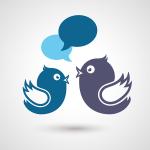Your Customer Service Team Needs Social Media Tools



When team members use social media to meet key objectives -- whether it’s reducing the number of issues, boosting the number of advocates and helping drive greater loyalty and repeat purchase -- it will be clear why they’re an important part of your arsenal.
For all the “likes,” emojis and reshares, social media is not just a big online popularity contest, especially if you’re using them as a business. They’re a conversation — which means you need to listen at least as much as you “talk.”
At some point or another, for example, a firm might decide to appoint a dedicated person or team of people who oversee social media activity, often as part of the marketing department. While the work those professionals do is incredibly important in terms of brand building, they are not necessarily equipped to cover off the customer service issues that may come through social media services.
Consider the expectations of customers who start following a business on Facebook, Twitter or Instagram. If they have been enjoying the blog posts, videos or other content you share on those channels, they may think of them first when they need to reach out with a question or a problem. In many organizations, however, the majority of investment and effort around customer service has been focused on more traditional channels, such as phone calls or perhaps email messages.
Social media team members who report into marketing, meanwhile, already tend to have a full plate just sharing content and driving engagement. It takes a lot of work to build a following, determine the best time of day to post and which content from the accounts you’re following you should comment on, like or reshare. Customer service is a very different activity, with a heightened sense of urgency, and which is directly related to things like retention and revenue that can affect the bottom line.
While this is by no means an exhaustive list, some of the benefits of equipping customer service teams with social media tools include:
1. Listening for Common Perceptions and Experiences
Great customer service isn’t just about solving problems but about creating the best possible environment for a customer to get the most out of the products or services in which they’ve invested.
Social listening tools can play a huge role here, even if the majority of outreach from customers continues to come via calls or emails. The technology allows organizations to conduct “sentiment analysis” for example, when a new product is launched by looking for the tone in comments and other social content that relates to it.
If many customers start posting similar questions about a product’s functionality, for instance, that may be a good indication of what kind of issues will be brought forward to the service team. This is where companies can be more proactive in developing FAQ lists and other self-help tools to address problems before they become too pervasive.
2. Containing Negative Publicity
Many people have no qualms calling out companies on social media when their experience didn’t meet their expectations. After all, given how much many firms spend on marketing their best qualities, it’s only fair that they be held to account occasionally.
While a few negative comments here and there might not seem like a big deal, social media services have the tendency to create a sort of snowball effect. Others may decide to join in, resharing the negative comments and even adding their own stories (which might not otherwise have been shared).
These outbursts tend to get even worse when customers believe the company in question is failing to respond or somehow hoping the discussion will go away. A strong customer service team that has access to social media tools will ensure the opposite happens. They’ll respond earlier and, in many cases, move the conversation to a more private, one-on-one-channel where they can resolve problems. In many cases customers may post follow-up comments that serve as the best word-of-mouth marketing a company can get.
3. Solving Problems Visually
Many social media services are inherently visual, including Facebook and Instagram. Even Twitter has become a place where a lot of videos and images are embedded directly into tweets. While there is great entertainment value in these channels, it also offers customer service teams considerable educational opportunities.
Think of the traditional customer service scenario, where an agent has to walk a customer through a troubleshooting process using only a phone call. Much of the time might be taken up simply by asking a customer to describe what they’re seeing. Social media allows customers to take and easily send videos that could accelerate the time to resolution in service environments.
Customer service teams can also go the extra mile by sharing informational content, such as infographics or tutorial videos, on social media to let customers solve problems on their own. Even a screenshot of a chatbot conversation that addresses a common issue could help others avoid similar difficulties.
4. Empowering the Team With More Data
Customer service managers have often listened back to recorded conversations within a call centre to improve the overall performance of the team, or scanned through emails for issues that require a broader fix. What customers say and share on social media represents a huge addition to the input they can get — and act upon.
Weaving social data into a tool like Service Cloud, for example, will make organizations smarter about the things that trip up the majority of their customers, which can then inform how service agents are trained.
At an individual level, meanwhile, agents will have a richer set of information about how customers have engaged with the company, beyond the conversations they’ve had with sales reps or the content they’ve consumed from the marketing department.
The best thing about using social media tools in customer service is that the return on investment can often be tied directly to the same metrics that assess the team’s overall performance. This could include things like customer satisfaction (CSAT), Net Promoter Score (NPS) or even Customer Effort Score (CES).
When team members use social media to meet key objectives — whether it’s reducing the number of issues, boosting the number of advocates and helping drive greater loyalty and repeat purchase — it will be clear why they’re an important part of your arsenal. In fact, it may not be long before you begin to wonder what you ever did without them.






















